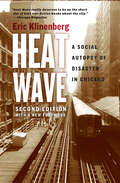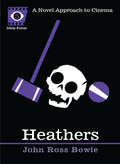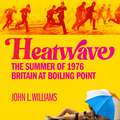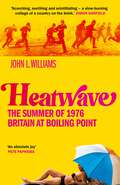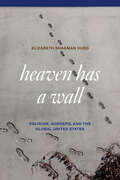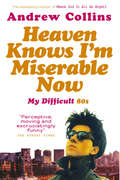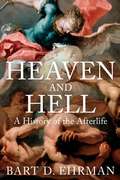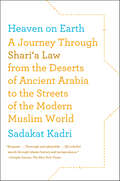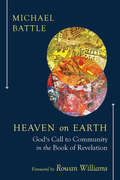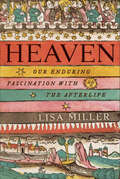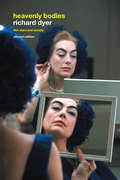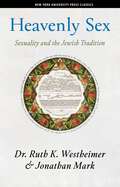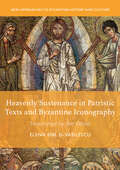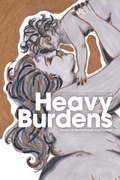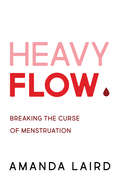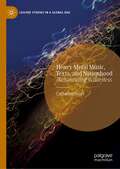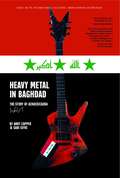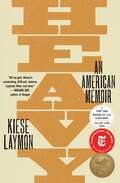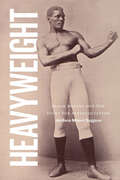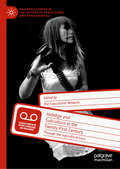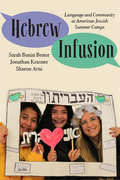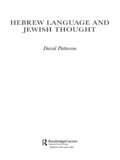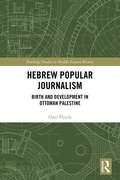- Table View
- List View
Heat Wave: A Social Autopsy of Disaster in Chicago
by Eric KlinenbergOn Thursday, July 13, 1995, Chicagoans awoke to a blistering day in which the temperature would reach 106 degrees. The heat index, which measures how the temperature actually feels on the body, would hit 126 degrees by the time the day was over. Meteorologists had been warning residents about a two-day heat wave, but these temperatures did not end that soon. When the heat wave broke a week later, city streets had buckled; the records for electrical use were shattered; and power grids had failed, leaving residents without electricity for up to two days. And by July 20, over seven hundred people had perished-more than twice the number that died in the Chicago Fire of 1871, twenty times the number of those struck by Hurricane Andrew in 1992--in the great Chicago heat wave, one of the deadliest in American history. Heat waves in the United States kill more people during a typical year than all other natural disasters combined. Until now, no one could explain either the overwhelming number or the heartbreaking manner of the deaths resulting from the 1995 Chicago heat wave. Meteorologists and medical scientists have been unable to account for the scale of the trauma, and political officials have puzzled over the sources of the city's vulnerability. In Heat Wave, Eric Klinenberg takes us inside the anatomy of the metropolis to conduct what he calls a "social autopsy," examining the social, political, and institutional organs of the city that made this urban disaster so much worse than it ought to have been. Starting with the question of why so many people died at home alone, Klinenberg investigates why some neighborhoods experienced greater mortality than others, how the city government responded to the crisis, and how journalists, scientists, and public officials reported on and explained these events. Through a combination of years of fieldwork, extensive interviews, and archival research, Klinenberg uncovers how a number of surprising and unsettling forms of social breakdown--including the literal and social isolation of seniors, the institutional abandonment of poor neighborhoods, and the retrenchment of public assistance programs--contributed to the high fatality rates. The human catastrophe, he argues, cannot simply be blamed on the failures of any particular individuals or organizations. For when hundreds of people die behind locked doors and sealed windows, out of contact with friends, family, community groups, and public agencies, everyone is implicated in their demise. As Klinenberg demonstrates in this incisive and gripping account of the contemporary urban condition, the widening cracks in the social foundations of American cities that the 1995 Chicago heat wave made visible have by no means subsided as the temperatures returned to normal. The forces that affected Chicago so disastrously remain in play in America's cities, and we ignore them at our peril. For the Second Edition Klinenberg has added a new Preface showing how climate change has made extreme weather events in urban centers a major challenge for cities and nations across our planet, one that will require commitment to climate-proofing changes to infrastructure rather than just relief responses.
Heathers: A Novel Approach to Cinema (Deep Focus #5)
by Sean Howe John Ross BowieWhat's your damage?In 1989, Michael Lehmann's black comedy Heathers drew a line in the sand, rebuffing the sweetness and optimism of John Hughes' more popular fare with darkness and death. Launching the careers of Winona Ryder and Christian Slater, Heathers became a cult classic, ranking #5 on Entertainment Weekly's list of the 50 Best High School Movies and inspiring hoards of teen films that vastly overshadow its fame but lack its acid wit, moral complexity, and undeniable emotional punch.For the latest installment of Deep Focus, John Ross Bowie blends captivating memoir with astute analysis, tracing the rebel-teen mythology that links Columbine, heavy metal, and The Catcher in the Rye. With help from Lehmann, screenwriter Daniel Waters, and members of the cast, Bowie thoroughly unpacks the film's peculiar resonance. Brilliant riffs on the etymology of its teen slang, the implications of its title, and its visual debt to Stanley Kubrick show how Heathers-for all its audacious absurdity-speaks volumes about the realities of high school and of life itself.
Heatwave: The Summer of 1976 – Britain at Boiling Point
by John L Williams'Grippingly captures the three months that shook Britain's cultural landscape' PAULINE BLACK'Scorching, seething and scintillating, Heatwave conjures a slow-burning collage of a country on the brink. I lived through those cruel months, and Williams recreates them with intense skill' SIMON GARFIELD'An absolute joy' PETE PAPHIDES'Engrossing...powerful...goes way beyond nostalgia' DAVID KYNASTONWith temperatures soaring to 35ºC, severe water shortages and a sunburned population queuing at the standpipes, the summer of 1976 was always remembered as Britain's hottest.But the wave that hit the UK that year was also cultural and political, with upheaval on the streets, in parliament, on the cricket pitch and on the radios and TV sets of a nation at a crossroads.Before this blistering summer, Britain seemed stuck in the post-war era, a country where people were all in it together - as long as you were white, male and straight. In July, Tom Robinson writes a song called Glad to be Gay, and by August bank holiday, Black youth are making the police run for their lives in the almighty riot at the Notting Hill Carnival. But with the Labour Prime Minister Harold Wilson suddenly quitting, the pound sinking and the economy tanking, a restless immigrant population and increasing dissatisfaction in the old world order, the weather seemed to boil up the country to the point where the lid blows off.Weaving a rich tapestry of the news stories of the year, with social commentary and dozens of first-person interviews with those that were there at the time, Williams's reappraisal of the summer of '76 is an evocative, sometimes nostalgic but always an unflinching read. Heatwave takes us back to relive the events of that summer and asks - have we really moved on as much as we would have liked?
Heatwave: The Summer of 1976 – Britain at Boiling Point
by John L Williams'Grippingly captures the three months that shook Britain's cultural landscape' PAULINE BLACK'Scorching, seething and scintillating, Heatwave conjures a slow-burning collage of a country on the brink. I lived through those cruel months, and Williams recreates them with intense skill' SIMON GARFIELD'An absolute joy' PETE PAPHIDES'Engrossing...powerful...goes way beyond nostalgia' DAVID KYNASTONWith temperatures soaring to 35ºC, severe water shortages and a sunburned population queuing at the standpipes, the summer of 1976 was always remembered as Britain's hottest.But the wave that hit the UK that year was also cultural and political, with upheaval on the streets, in parliament, on the cricket pitch and on the radios and TV sets of a nation at a crossroads.Before this blistering summer, Britain seemed stuck in the post-war era, a country where people were all in it together - as long as you were white, male and straight. In July, Tom Robinson writes a song called Glad to be Gay, and by August bank holiday, Black youth are making the police run for their lives in the almighty riot at the Notting Hill Carnival. But with the Labour Prime Minister Harold Wilson suddenly quitting, the pound sinking and the economy tanking, a restless immigrant population and increasing dissatisfaction in the old world order, the weather seemed to boil up the country to the point where the lid blows off.Weaving a rich tapestry of the news stories of the year, with social commentary and dozens of first-person interviews with those that were there at the time, Williams's reappraisal of the summer of '76 is an evocative, sometimes nostalgic but always an unflinching read. Heatwave takes us back to relive the events of that summer and asks - have we really moved on as much as we would have liked?
Heatwave: The Summer of 1976 – Britain at Boiling Point
by John L Williams'Grippingly captures the three months that shook Britain's cultural landscape' PAULINE BLACK'Scorching, seething and scintillating, Heatwave conjures a slow-burning collage of a country on the brink. I lived through those cruel months, and Williams recreates them with intense skill' SIMON GARFIELD'An absolute joy' PETE PAPHIDES'Engrossing...powerful...goes way beyond nostalgia' DAVID KYNASTONWith temperatures soaring to 35ºC, severe water shortages and a sunburned population queuing at the standpipes, the summer of 1976 was always remembered as Britain's hottest.But the wave that hit the UK that year was also cultural and political, with upheaval on the streets, in parliament, on the cricket pitch and on the radios and TV sets of a nation at a crossroads.Before this blistering summer, Britain seemed stuck in the post-war era, a country where people were all in it together - as long as you were white, male and straight. In July, Tom Robinson writes a song called Glad to be Gay, and by August bank holiday, Black youth are making the police run for their lives in the almighty riot at the Notting Hill Carnival. But with the Labour Prime Minister Harold Wilson suddenly quitting, the pound sinking and the economy tanking, a restless immigrant population and increasing dissatisfaction in the old world order, the weather seemed to boil up the country to the point where the lid blows off.Weaving a rich tapestry of the news stories of the year, with social commentary and dozens of first-person interviews with those that were there at the time, Williams's reappraisal of the summer of '76 is an evocative, sometimes nostalgic but always an unflinching read. Heatwave takes us back to relive the events of that summer and asks - have we really moved on as much as we would have liked?
Heaven Has a Wall: Religion, Borders, and the Global United States
by Elizabeth Shakman HurdAn urgent exploration of borders as sacred objects in American culture. Our national conversation about the border has taken a religious turn. When televangelists declare, “Heaven has a wall,” activists shout back, “Jesus was a refugee.” For Elizabeth Shakman Hurd, the standoff makes explicit a longstanding truth: borders are religious as well as political objects. In this book, Hurd argues that Americans share a bipartisan border religion, complete with an array of beliefs and practices, including a reverence for national security, a liturgy for immigration, and an eschatological foreign policy. Through an analysis of the many ways the United States creates, enforces, and ignores borders at home and abroad, Hurd offers a bold new perspective on the ties that bind American religion, politics, and public life.
Heaven Knows I'm Miserable Now: My Difficult 80s
by Andrew Collins'Higher education comes at exactly the right time: in the twilight of your teens, you're just starting to coagulate as a human being, to pull away from parental influence and find your own feet. What better than three years in which to explore the inner you, establish a feasible worldview, and maybe get on Blockbusters.'After an idyllic provincial 1970s childhood, the 1980s took Andrew Collins to London, art school and the classic student experience. Crimping his hair, casting aside his socks and sporting fingerless gloves, he became Andy Kollins: purveyor of awful poetry; disciple of moany music, and wannabe political activist. What follows is a universal tale of trainee hedonism, girl trouble, wasted grants and begging letters to parents. A synth-soundtracked rite of passage that's often painfully funny, it traces one teenager's metamorphosis from sheltered suburban innocent to semi-mature metropolitan male through the pretensions and confusions of trying to stand alone for the first time in your own kung fu pumps in a big bad city.
Heaven and Hell: A History of the Afterlife
by Bart D. EhrmanWhether we believe in them or not, we are all familiar with the concepts of heaven and hell. There was a time, however, when no one thought they would go to either of these places after they died. In fact, Jesus didn&’t believe a dead person&’s soul was bound for heaven or hell, and these ideas are nowhere to be found in the Old Testament. So, where did they come from? From the Epic of Gilgamesh to the writings of Augustine, Bart Ehrman provides a fascinating and thought-provoking history of the afterlife. He traces how beliefs changed over time and reveals the social, cultural and historical roots of competing views held by Greeks, Jews and Christians. Ultimately, he shows that many of our ideas about heaven and hell emerged long after Jesus&’s time, through the struggle to explain the injustices of our world.
Heaven on Earth: A Journey Through Shari'a Law from the Deserts of Ancient Arabia to the Streets of the Modern Muslim World
by Sadakat KadriHeaven on Earth is a vivid, revealing, and essential narrative history of shari'a law--the widely contested and misunderstood code of Islamic justice--and how the application of its concepts has changed over time and, with it, the face of Islam.Some fourteen hundred years after the Prophet Muhammad first articulated God's law--the shari'a--its earthly interpreters are still arguing about what it means. Hard-liners reduce it to amputations, veiling, holy war, and stonings. Others say that it is humanity's only guarantee of a just society. And as colossal acts of terrorism made the word "shari'a" more controversial than ever in the early twentieth century, the legal historian and human rights lawyer Sadakat Kadri realized that many people in the West harbored ideas about Islamic law that were hazy or simply wrong. Heaven on Earth describes his journey, through ancient texts and across modern borders, in search of the facts behind the myths.Kadri brings lucid analysis and enlivening wit to the turbulent story of Islam's foundation and expansion, showing how the Prophet Muhammad's teachings evolved gradually into concepts of justice. Traveling the Muslim world to see the shari'a's principles in action, he encounters a cacophony of legal claims. At the ancient Indian grave of his Sufi ancestor, unruly jinns are exorcised in the name of the shari'a. In Pakistan's madrasas, stern scholars ridicule his talk of human rights and demand explanations for NATO drone attacks in Afghanistan. In Iran, he hears that God is forgiving enough to subsidize sex-change operations--but requires the execution of Muslims who change religion. Yet the stories of compulsion and violence are only part of a picture that also emphasizes compassion and equity. Many of Islam's first judges refused even to rule on cases for fear that a mistake would damn them, and scholars from Delhi to Cairo maintain that governments have no business enforcing faith.The shari'a continues to shape explosive political events and the daily lives of more than a billion Muslims. Heaven on Earth is a brilliantly iconoclastic tour through one of humanity's great collective intellectual achievements--and an essential guide to one of the most disputed but least understood controversies of modern times.
Heaven on Earth: God's Call To Community In The Book Of Revelation
by Michael BattleMuch of the literature on the book of Revelation paints a frightening apocalyptic vision of the end times. Michael Battle offers an alternative look at Revelation in this new work, seeing it instead as a hopeful call to bring heaven on earth. Battle explores the problematic imagery found in Revelation before showing how similar problems play out in our contemporary world. Battle sees Revelation as a guide that shows us that we can live out God's call for heaven on earth by living in community with one another, as exhibited through the writings of Martin Luther King Jr., Desmond Tutu, Rowan Williams, and Ubuntu theology. He writes, "I seek to imagine in my particular Christian context how a view of heaven need not lead to culture wars and further excuses for oppressing others. Heaven, as envisioned by John of Patmos, has much greater purpose."
Heaven: Our Enduring Fascination with the Afterlife
by Lisa Miller“Wonderful…. A smart and accessible take on the ultimate question: What is Heaven? Lisa’s book is a good place to begin to find an answer.” — Jon Meacham, Pulitzer Prize-winning author of American Lion“A rare combination of journalism, memoir, and historical research … this smart yet heartfelt book leads us into the center of one of the greatest conversations of all time. And Lisa Miller is the perfect conversation partner.” — Stephen Prothero, New York Times bestselling author of American Jesus and Religious LiteracyA groundbreaking history of the hereafter, Heaven by Newsweek reporter and religion editor Lisa Miller draws from both history and popular culture to reveal how past and presage visions of heaven have evolved and how they inspire us to both good and evil.
Heavenly Bodies: Film Stars and Society (Bfi Cinema Ser.)
by Richard DyerRichard Dyer's classic study of movie stars and stardom has been updated, with a new introduction by the author discussing the rise of celebrity culture and developments in the study of stars since publication of the first edition in 1986. Dyer's illuminating study is based around case studies of three major stars: Marilyn Monroe, Paul Robeson and Judy Garland. He draws on a wide range of sources, including the films in which each star appeared, to illustrate how each star's persona was constructed, and goes on to examine each within the context of particular issues in fan culture and stardom. Students of film and cultural studies will find this an invaluable part of there course reading.
Heavenly Sex: Sexuality and the Jewish Tradition
by Dr. Ruth Westheimer Jonathan MarkCelebrated sex expert and bestselling author Dr. Ruth Westheimer bridges the gap between sex and religion in this provocative exploration of intimacy in the Jewish faithIn this light-hearted, lively tour of Jewish sexuality, Dr. Ruth K. Westheimer and Jonathan Mark team up to reveal how the Jewish tradition is much more progressive than popular wisdom might lead one to believe.Applying Dr. Ruth’s acclaimed brand of couples therapy to such Biblical relationships as Abraham and Sarah, and Joseph and Potiphar’s wife, the authors enlist Biblical lore to explore such topics as surrogacy, incest, and arranged marriages. They offer a clearer understanding of the intertwining relationships between sexuality and spirituality through incisive investigations of the Song of Songs, Ruth, Proverbs, Psalms, and some of the bawdier tales of the Prophets. One chapter provides a provocative new perspective on the Sabbath as a weekly revival, highlighting not only its spiritual nature, but also its marital and sexual aspects.Focusing specifically on Orthodox forms of Judaism and offering Dr. Ruth's singular interpretations, the book answers such questions as: What night of the week is best for making love? How often should couples have sex? Can traditional Jewish notions of sex and sexuality be reconciled with contemporary beliefs? What roles can and do dreams and fantasy play?In Heavenly Sex, America's favorite sex therapist takes readers on a frank and fascinating journey to the heart of Jewish sexuality as she fits twenty-first century sexual mores into an ancient—and lusty—spiritual tradition.
Heavenly Sustenance in Patristic Texts and Byzantine Iconography: Nourished by the Word (New Approaches to Byzantine History and Culture)
by Elena Ene D-VasilescuThis book examines ideas of spiritual nourishment as maintained chiefly by Patristic theologians –those who lived in Byzantium. It shows how a particular type of Byzantine frescoes and icons illustrated the views of Patristic thinkers on the connections between the heavenly and the earthly worlds. The author explores the occurrence, and geographical distribution, of this new type of iconography that manifested itself in representations concerned with the human body, and argues that these were a reaction to docetist ideas. The volume also investigates the diffusion of saints’ cults and demonstrates that this took place on a North-South axis as their veneration began in Byzantium and gradually reached the northern part of Europe, and eventually the entirety of Christendom.
Heavy Burdens: Stories Of Motherhood And Fatness
by Judy VerseghyHeavy Burdens: Stories of Motherhood and Fatness seeks to address the systemic ways in which the moral panic around “obesity” impacts fat mothers and fat children. Taking a life-course approach, the book begins with analyses of the ways in which fatphobia is enacted on pregnant (or even not-yet-pregnant) women, whose bodies immediately become viewed as objects warranting external control by not only medical professionals, but family members, and even passers-by. The story unfolds as adults recount childhood stories of growing up fat, or growing up in fear of being fat, and how their mothers’ relationships with their own bodies and attempted weight-loss experiences shaped how food, exercise, and body management were approached in their homes in sometimes harmful ways. Finally, the book concludes with stories of women who have since become mothers, examining the ways in which having their own children altered their views on their own bodies and their perceptions of their mothers’ actions, and working to find fat-friendly futures via their own parenting (or grand-parenting) techniques.
Heavy Business: Commercial Burglary and Robbery (Routledge Library Editions: Criminology)
by Dermot WalshOriginally published in 1986. Based on interviews with men in prison, this study takes two groups of convicted criminals: men convicted of robbery, and, for comparison, a sample of men convicted for breaking into commercial premises. It focuses on how victims are chosen, the decision-making processes involved, and the characteristics of those selected and those rejected as unsuitable potential victim material. Also described are the pattern of the crime (time, place, gain), and the ways in which people become involved in it. Allowing several convicted robbers describe in their own way why they did it and what they thought and felt about it, Dermot Walsh presents a disquieting picture, in which robbery appears to be an attractive proposition to several different groups of men, facing quite different circumstances, and for different reasons.
Heavy Flow: Breaking the Curse of Menstruation
by Amanda LairdWhat do you know about your menstrual cycle? Your menstrual cycle is your fifth vital sign — a barometer of health and wellness that is as telling as your pulse or blood pressure. Yet most of us see our periods as nothing more than a source of inconvenience and embarrassment. The reasons for this are vast and complex and many are rooted in misogyny. The fact is, women the world over are taught the bare minimum about menstruation, and the messages they do receive are negative: that periods are painful and gross, that they turn us into hormonal messes, and that they shouldn't be discussed. By examining the history of period shame and stigma and its effects on women’s health and wellness today as well as providing a crash course in menstrual self-care, Heavy Flow aims to lift the veil on menstruation, breaking the "curse" once and for all.
Heavy Metal Music, Texts, and Nationhood: (Re)sounding Whiteness (Leisure Studies in a Global Era)
by Catherine HoadThis book addresses how whiteness is represented in heavy metal scenes and practices, both as a site of academic inquiry and force of cultural significance. The author argues that whiteness, and more specifically white masculinity, has been given normative value which obscures the contributions of women and people of colour, and affirms the exclusory understandings of ‘belonging’ which have featured in the metal scenes of Norway, South Africa, and Australia. Utilizing critical discourse analysis and critical textual analysis of musical texts, promotional material, and participant-based observation ethnographies, it explores how the texts, discourses, and practices produced and articulated by metal scene members and scholars alike have presented heavy metal as a white, masculine pastime, yet also considers the vital work done by scene members to confront expressions of exclusory misogyny and racism when they emerge in metal scenes. The book will be of interest to researchers and scholars in the fields of metal music studies, leisure studies, sociology of culture and sociology of racism.
Heavy Metal in Baghdad: The Story of Acrassicauda
by Andy Capper Vice Mediadocumentary Heavy Metal in Baghdad featuring the members of Iraq's only heavy metal band--Acrassicauda--and their daily struggle to survive and rock on even as their country fell into a bloody insurgency. Acrassicauda (Latin for a deadly black scorpion) is Iraq's only heavy metal band. Inspired by groups like Metallica, Slayer, and Slipknot, the band began writing and playing metal in 2001, performing a handful of shows before the war started in 2003. With increased security precautions throughout Iraq, it became difficult to practice or even get through a show without serious problems. When they began receiving death threats from insurgent groups and religious fundamentalists accused them of Satan-worship, they became a band on the run. As recently seen in the feature film documentary of the same name, Iraq disintegrated around them while Acrassicauda struggled to stay together and stay alive, always refusing to let their heavy metal dreams die. Their story echoes the unspoken hopes of an entire generation of young Iraqis, and it became a race-against-time humanitarian effort, irrevocably transforming everyone's lives in the process. Going beyond the documentary to explore all the players' unique perspectives, Heavy Metal in Baghdad features new information about one of the most dramatic and unique stories in modern music.
Heavy: An American Memoir
by Kiese LaymonIn this powerful and provocative memoir, genre-bending essayist and novelist Kiese Laymon explores what the weight of a lifetime of secrets, lies, and deception does to a black body, a black family, and a nation teetering on the brink of moral collapse. <p><p> Kiese Laymon is a fearless writer. In his essays, personal stories combine with piercing intellect to reflect both on the state of American society and on his experiences with abuse, which conjure conflicted feelings of shame, joy, confusion and humiliation. Laymon invites us to consider the consequences of growing up in a nation wholly obsessed with progress yet wholly disinterested in the messy work of reckoning with where we’ve been. In Heavy, Laymon writes eloquently and honestly about growing up a hard-headed black son to a complicated and brilliant black mother in Jackson, Mississippi. <p> From his early experiences of sexual violence, to his suspension from college, to his trek to New York as a young college professor, Laymon charts his complex relationship with his mother, grandmother, anorexia, obesity, sex, writing, and ultimately gambling. By attempting to name secrets and lies he and his mother spent a lifetime avoiding, Laymon asks himself, his mother, his nation, and us to confront the terrifying possibility that few in this nation actually know how to responsibly love, and even fewer want to live under the weight of actually becoming free. <p> A personal narrative that illuminates national failures, Heavy is defiant yet vulnerable, an insightful, often comical exploration of weight, identity, art, friendship, and family that begins with a confusing childhood—and continues through twenty-five years of haunting implosions and long reverberations. <P><b>Winner of the 2018 Andrew Carnegie Medal for Non-Fiction</b>
Heavyweight: Black Boxers and the Fight for Representation
by Jordana Moore SaggeseIn Heavyweight, Jordana Moore Saggese examines images of Black heavyweight boxers to map the visual terrain of racist ideology in the United States, paying particular attention to the intersecting discourses of Blackness, masculinity, and sport. Looking closely at the “shadow archive” of portrayals across fine art, vernacular imagery, and public media at the turn of the twentieth century, shedemonstrates how the images of boxers reveal the racist stereotypes implicit in them, many of which continue to structure ideas of Black men today. With a focus on both anonymous fighters and notorious champions, including Jack Johnson, Saggese contends that popular images of these men provided white spectators a way to render themselves experts on Blackness and Black masculinity. These images became the blueprint for white conceptions of the Black male body—existing between fear and fantasy, simultaneously an object of desire and an instrument of violence. Reframing boxing as yet another way whiteness establishes the violent mythology of its supremacy, Saggese highlights the role of imagery in normalizing a culture of anti-Blackness.
Hebdige and Subculture in the Twenty-First Century: Through the Subcultural Lens (Palgrave Studies in the History of Subcultures and Popular Music)
by John Street Peter Webb Lucy Robinson Matthew Worley Keith Gildart Anna Gough-Yates Sian Lincoln Bill OsgerbyThis book assesses the legacy of Dick Hebdige and his work on subcultures in his seminal work, Subculture: The Meaning of Style (1979). The volume interrogates the concept of subculture put forward by Hebdige, and asks if this concept is still capable of helping us understand the subcultures of the twenty-first century. The contributors to this volume assess the main theoretical trends behind Hebdige’s work, critically engaging with their value and how they orient a researcher or student of subculture, and also look at some absences in Hebdige’s original account of subculture, such as gender and ethnicity. The book concludes with an interview with Hebdige himself, where he deals with questions about his concept of subculture and the gestation of his original work in a way that shows his seriousness and humour in equal measure. This volume is a vital contribution to the debate on subculture from some of the best researchers and academics working in the field in the twenty-first century.
Hebrew Infusion: Language and Community at American Jewish Summer Camps
by Sarah Bunin Benor Jonathan Krasner Sharon AvniEach summer, tens of thousands of American Jews attend residential camps, where they may see Hebrew signs, sing and dance to Hebrew songs, and hear a camp-specific hybrid language register called Camp Hebraized English, as in: “Let’s hear some ruach (spirit) in this chadar ochel (dining hall)!” Using historical and sociolinguistic methods, this book explains how camp directors and staff came to infuse Hebrew in creative ways and how their rationales and practices have evolved from the early 20th century to today. Some Jewish leaders worry that Camp Hebraized English impedes Hebrew acquisition, while others recognize its power to strengthen campers’ bonds with Israel, Judaism, and the Jewish people. Hebrew Infusion explores these conflicting ideologies, showing how hybrid language can serve a formative role in fostering religious, diasporic communities. The insightful analysis and engaging descriptions of camp life will appeal to anyone interested in language, education, or American Jewish culture.
Hebrew Language and Jewish Thought (Routledge Jewish Studies Series)
by David PattersonDrawing on more than three hundred Hebrew roots, the author shows that Jewish thought employs Hebrew concepts and categories that are altogether distinct from those that characterize the Western speculative tradition. Among the key categories that shape Jewish thought are holiness, divinity, humanity, prayer, responsibility, exile, dwelling, gratitude, and language itself. While the Hebrew language is central to the investigation, the reader need not have a knowledge of Hebrew in order to follow it. Essential reading for students and scholars of Judaism, this book will also be of value to anyone interested in the categories of thinking that form humanity's ultimate concerns.
Hebrew Popular Journalism: Birth and Development in Ottoman Palestine (Routledge Studies in Middle Eastern History)
by Ouzi ElyadaThe book examines the birth, development, and mode of operation of the Hebrew popular press that progressed in Ottoman Palestine between 1884 and the eruption of World War I in 1914. The inquiry yields a profile of the printers, editors, and journalists, and examines the editors’ working patterns, the gathering of journalistic information, and distribution of the resulting product in the public sphere. Addressing the fact that nearly all of the Hebrew press in the eighteenth and nineteenth centuries appealed to an elitist intellectual and affluent readership, the book breaks new ground by showing that from the 1880s onward, a popular press came into being in Palestine for the first time in the history of the Hebrew press. The focus is on three popular newspapers that evolved in Jerusalem along the lines of the Western popular press. While profiling the readership of the popular Hebrew press the book also investigates reading practices. Analyzing the contribution of the press to the modernization of the Hebrew language, this pioneering volume is a key resource for students and scholars of communication, media and Hebrew studies, and media and Jewish history.
